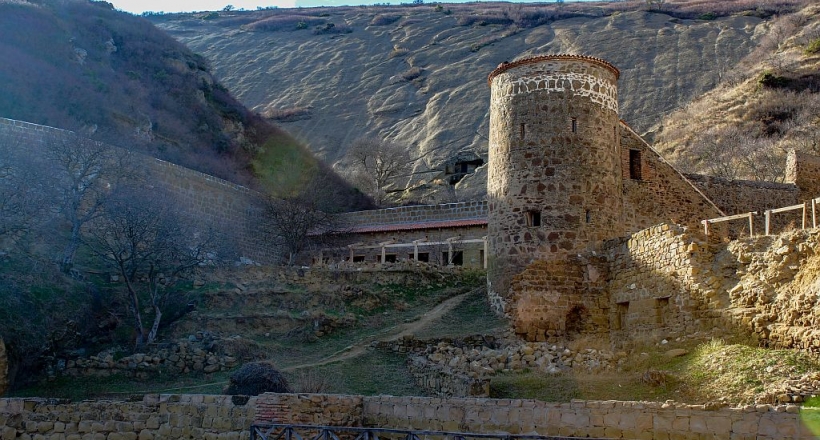David Gareja Monastery complex probably is among top tourist attractions in Republic of Georgia you should visit. Located in the desert, bordering with Azerbaijan this place provides very spectacular views. Best ways to get here is either by using your own vehicle or hiring a driver or booking a trip.
The monastery complex includes hundreds of cells, churches, chapels, refectories and living quarters hollowed out of the rock face.

David Gareja Monastery Complex in Georgia
The complex was founded in the 6th century by David (St. David Garejeli), one of the thirteen Assyrian monks who arrived in the country at the same time.

Cells in David Gareja monastery complex
A group of Latvian tourists in the middle of David Gareja monastery complex

Tower in Monastery complex
The convent was particularly patronized by the Georgian royal and noble families. The 12th-century Georgian king Demetre I, the author of the famous Georgian hymn Thou Art a Vineyard, even chose David Gareja as a place of his confinement after he abdicated the throne.

Fortification wall at monastery complex
With the downfall of the Georgian monarchy, the monastery suffered a lengthy period of decline and devastation by the Mongol army (1265), but was later restored by the Georgian kings. It survived theSafavid attack of 1615, when the monks were massacred and the monastery's unique manuscripts and important works of Georgian art destroyed, to be resurrected under Onopre Machutadze, who was appointed Father Superior of David Gareja in 1690.

Desert surrounding David Gareja monastery complex in Georgia
After the violent Bolshevik takeover of Georgia in 1921, the monastery was closed down and remained uninhabited. In the years of the Soviet War in Afghanistan, the monastery's territory was used as a training ground for the Soviet military that inflicted damage to the unique cycle of murals in the monastery. In 1987, a group of Georgian students led by the young writer Dato Turashvili launched a series of protests. Although, the Soviet defense ministry officials finally agreed to move a military firing range from the monastery, the shelling was resumed in October 1988, giving rise to generalized public outrage. After some 10,000 Georgians demonstrated in the streets of Tbilisi and a group of students launched a hunger strike at the monastery, the army base was finally removed.

Desert in Georgia
About David Gareja monastery complex
David Gareja is a rock-hewn Georgian Orthodox monastery complex located in the Kakheti region of Eastern Georgia, on the half-desert slopes of Mount Gareja, some 60–70 km southeast of Georgia's capital Tbilisi. The complex includes hundreds of cells, churches, chapels, refectories and living quarters hollowed out of the rock face.
Part of the complex is located in the Agstafa rayon of Azerbaijan and has become subject to a border dispute between Georgia and Azerbaijan.The area is also home to protected animal species and evidence of some of the oldest human habitations in the region.
